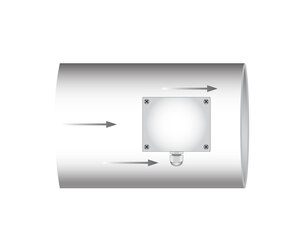EU declaration conformity
Duct CO2 sensor | PoM
Product description
CO2 meter for ducts. It measures temperature, relative humidity, and CO2 (carbon dioxide) in air ducts.
The power supply voltage is 24 V DC PoM, which means that Modbus RTU communication and a 24 V DC power supply can be connected using a single RJ45 connector. Modbus RTU communication is used to transmit the measured values and allows for the adjustment of all settings. The CO2 sensor element is replaceable and self-calibrating.
Documents
Additional specifications and description
Optimised for air ducts 
When people breathe, they produce CO2 or carbon dioxide. As a result, CO2 concentration is a good predictor of a space's occupancy and activity level. CO2 sensors are used as an indicator of ventilation requirements in many applications. This HVAC transmitter detects temperature, relative humidity, and CO2 levels in air ducts. The dew point is calculated based on the temperature and humidity. This sensor works best if it is installed in a straight section of the air duct. Avoid installing in turbulent air zones near filters, fans, cooling coils, and so on. Position the sensor correctly in relation to the airflow direction. More detailed information can be found in the mounting instructions.

When people breathe, they produce CO2 or carbon dioxide. As a result, CO2 concentration is a good predictor of a space's occupancy and activity level. CO2 sensors are used as an indicator of ventilation requirements in many applications. This HVAC transmitter detects temperature, relative humidity, and CO2 levels in air ducts. The dew point is calculated based on the temperature and humidity. This sensor works best if it is installed in a straight section of the air duct. Avoid installing in turbulent air zones near filters, fans, cooling coils, and so on. Position the sensor correctly in relation to the airflow direction. More detailed information can be found in the mounting instructions.
NDIR sensor technology
NDIR or Non-dispersive Infrared technology is used to measure the CO2 level. This technology offers a low life-cycle cost and a precise and stable long-term operation.
NDIR or Non-dispersive Infrared technology is used to measure the CO2 level. This technology offers a low life-cycle cost and a precise and stable long-term operation.
Reduced installation time
This sensor can be connected with just one RJ45 connector. Modbus RTU communication and the 24 V DC power supply are connected via a single UTP cable. Modbus RTU communication makes all measured values available. To make wiring easier, we recommend using a Sentera 24 VDC power supply with an RJ45 connector. These power supplies provide short-circuit, overload, and overvoltage protection. A supply voltage of 24 V DC improves the safety and reliability of your installation.
This sensor does not have analogue outputs which makes it simpler and more cost efficient. All measured values are available via the Modbus input registers of this sensor. Reading the measured values is possible via SenteraWeb - our online HVAC platform, via 3SModbus software, via a BMS system or via another Modbus master device. Modbus has numerous advantages. The most important ones are that digital signals are less susceptible to interference than analogue signals and that longer cables can be used. Cable lengths of up to 1.000 meters are possible.
Easy to use
This sensor requires very little configuration. It is almost directly usable once it has been installed. Temperature and relative humidity are often region- and seasonal-specific. These parameters are still adjusted to the correct values during installation. The other default settings will be suitable for most applications. However, they can also be adjusted via the respective Modbus registers if necessary.
Self-calibrating to compensate sensor drift
The ABC logic self-calibrating algorithm is by default enabled. This algorithm is designed to be used in applications where CO2 concentrations will drop to outside ambient conditions (400 ppm) at least once (15 minutes) in a 7day period, which is typically seen during unoccupied periods. The sensor will reach its operational accuracy after 25 hours of continuous operation at a condition that it was exposed to ambient reference levels of air at 400 ppm ± 10 ppm CO2.
The ABC logic self-calibrating algorithm is by default enabled. This algorithm is designed to be used in applications where CO2 concentrations will drop to outside ambient conditions (400 ppm) at least once (15 minutes) in a 7day period, which is typically seen during unoccupied periods. The sensor will reach its operational accuracy after 25 hours of continuous operation at a condition that it was exposed to ambient reference levels of air at 400 ppm ± 10 ppm CO2.
Air ducts
The enclosure is optimised for CO2 measurements in air ducts. It offers an IP54 protection against ingress of dust and moisture. The sensor element is integrated in the probe of the duct sensor. This probe has an opening to have a direct contact between the air flow and the sensor element. The sensor probe offers an IP20 protection.
The enclosure is optimised for CO2 measurements in air ducts. It offers an IP54 protection against ingress of dust and moisture. The sensor element is integrated in the probe of the duct sensor. This probe has an opening to have a direct contact between the air flow and the sensor element. The sensor probe offers an IP20 protection.






.webp)
.webp)
.webp)
.webp)
.webp)




Remarks, reviews & ratings